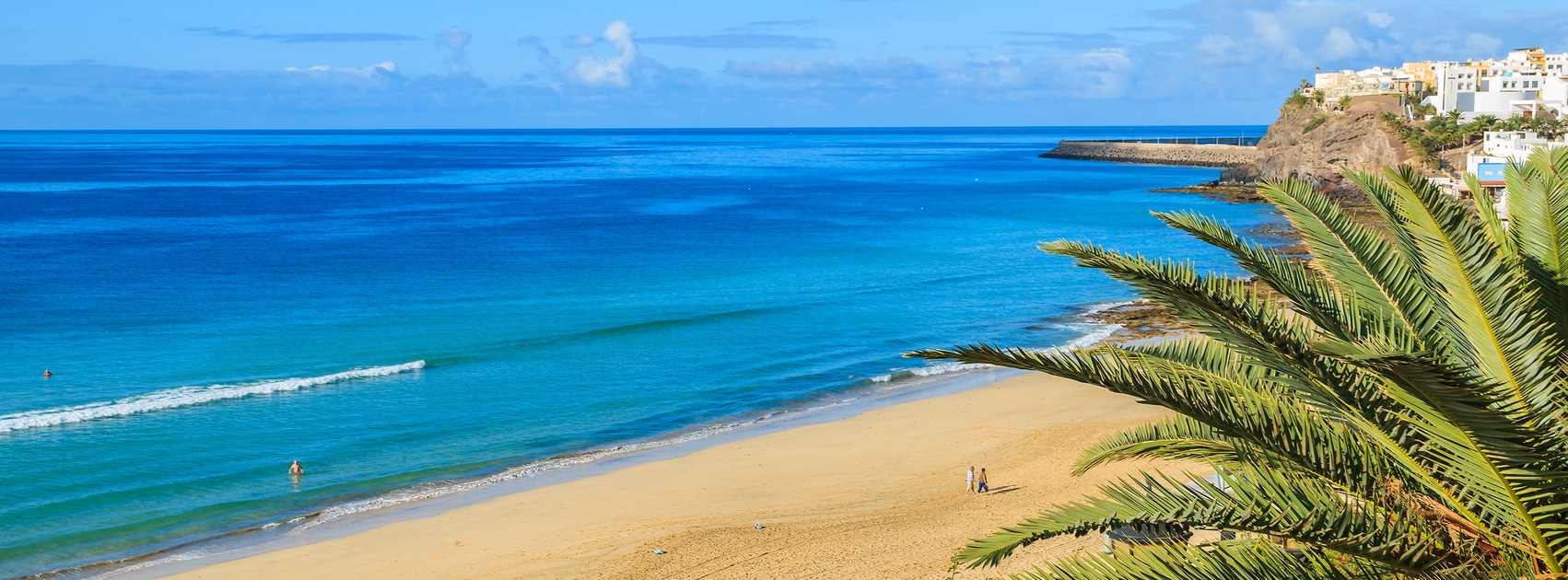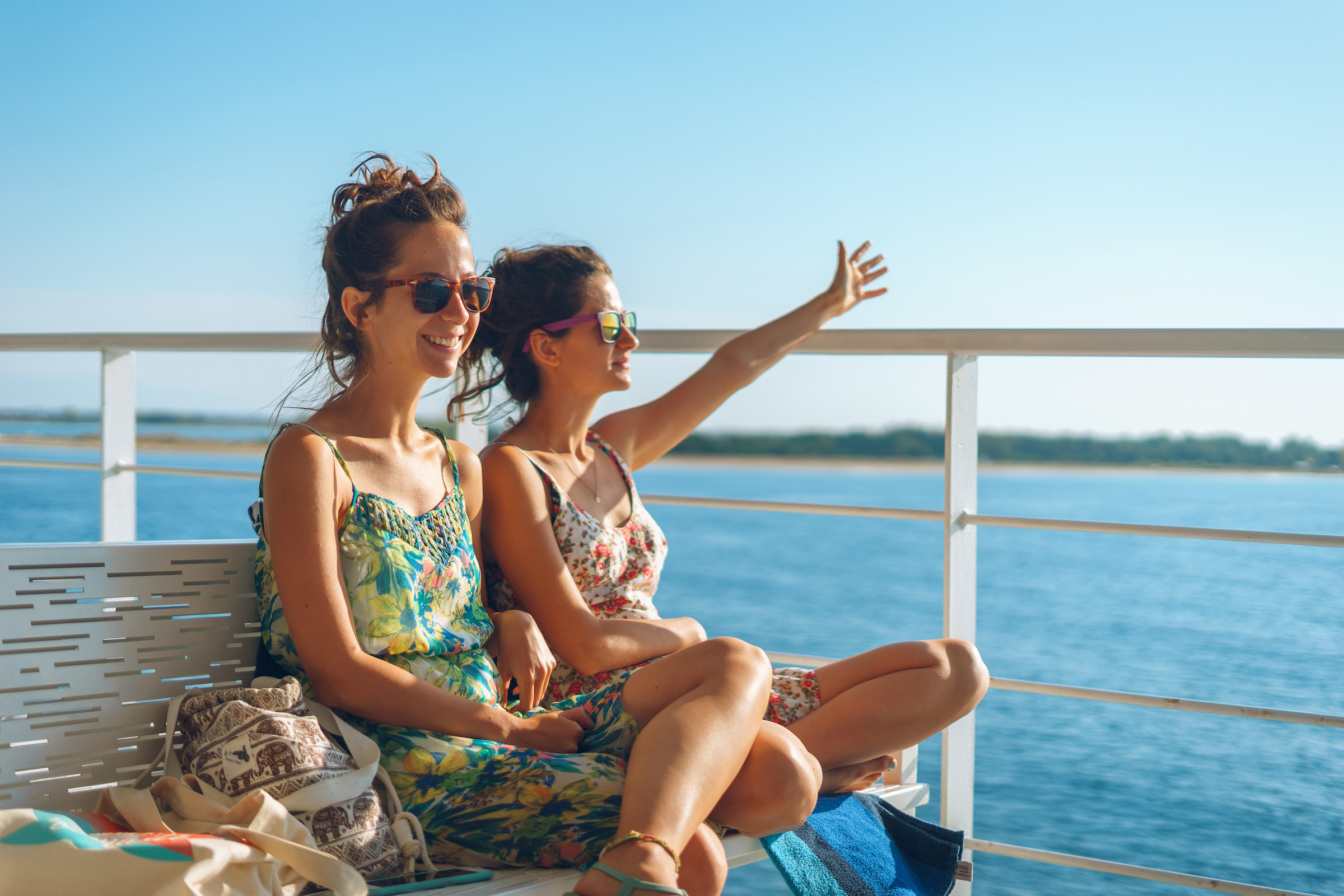But even "Fuerte" is by no means flat as a flounder. To get a panoramic view, one should make an effort to the Betancuria massif with the peak of Montana Tegú. The view from the Mirador de Morro Velosa is unique. Long beach walks and recently also tours on great bike paths are a hit on Fuerteventura.
Fuerteventura - the "Sun Queen
The question is always the same: What does the vacationer need for a carefree beach vacation? The answer can be found on the Canary Island of Fuerteventura: the blue sea, an endless sandy beach and of course sunshine galore! It is said of "Fuerte" that it is the "mistress of the Sahara". This has undoubtedly its reasons, because the second largest island of the archipelago is located just 95 kilometers off the African coast. Every now and then, the sun hides behind a reddish-gray veil on Fuerteventura. Then the locals speak of the "Calima" and know that the hot storm is a temporary phenomenon and the pinprick massage the other day is a thing of the past. Fuerteventura is three things: steppe, desert and beach.
The unwilling spirit of a philosopher
This island is not a green paradise like many others of the archipelago on the threshold of Africa. It is characterized rather by its brittle charm, but who walks with open eyes on the beach, enjoys the pretty little villages or is on the way on the beautiful new cycle tracks, sees this island with completely different eyes than once the Spanish philosopher Miguel de Unamuno. He described Fuerteventura around 1900 as a "naked, barren land of nothing but bones..." Now we know that the Basque was an unwilling and indomitable spirit and that at that time the military dictator Primo de Rivera had banished him to Fuerteventura because of a newspaper article.
Donkeys and oxen populated the streets
Miguel de Unamuno was already an old man when he was banished to Fuerteventura. He experienced the island as a lonely isle, far away from any civilization. Only about 7000 people were at home here, and the capital Puerto del Rosario was then called Puerto de Cabras - the port of the goats.
Donkeys, oxen, mules and dromedaries alone populated the streets, on which otherwise only water carriers were on the move, supplying the houses of the small town with cool water from the well. A monument to Unamuno was erected at the foot of the Montana Quemada. Today, most tourists drive past this narrow statue carelessly. Unamuno managed to escape and spent the last years of his life in exile in Paris.
On the back of a dromedary across the beach
The "goat port" of yore became a vibrant tourist stronghold in the 20th century - but dromedaries still exist on Fuerteventura. They used to be used as beasts of burden in the barren fields and pulled the wooden plows. The animals from Africa were also very popular on the island because the volcanic soil there is often soft and because the dromedaries had no problems as calluses in the fields. But today you can see the "desert ships" actually only where they are on excursions with vacationers. Rides over the beach of La Lajita are a wobbly and somewhat adventurous pleasure.
On "Fuerte" the air tastes of salt
Not only sensitive minds feel it very quickly after arriving on Fuerteventura: Here the air tastes of salt, and when the hot wind tugs at your hair, there is no doubt: You have arrived on an unusual island. But one should not be deceived by the first glance, because this island of the Canary Islands is by no means hostile to life or even inhospitable.
It is true that in some regions there is practically nothing where the gaze can find a stopping point as far as the horizon, but even the monotony finds its terminus here: wherever a few green palm trees rise after the emptiness and where pleasant hotels and inviting restaurants can be found in the small villages. Here man has put a stop to the impending apocalypse and given the color "green" to the eye.
In the morning the dunes are as if freshly blow-dried
But Fuerteventura is first and foremost an island of beachcombers. It is the "sun queen" of the archipelago off the African continent. With a total of fifty kilometers of beaches, it is no wonder that many sun worshippers have chosen this island as one of their favorite destinations.
Fine is the sand there. Sometimes it is pitch black, like the lava flows from the volcanoes. And then it presents itself golden yellow. When there is more than a light breeze, many stretches of beach look in the morning as if many hard-working helpers had raked the sand during the night. And behind the freshly blow-dried dunes, the sea beckons with crystal-clear water. Families with their children will also find their bathing El Dorado here, because the beach slopes gently down to the sea almost everywhere.
Riddle about the meaning of the island name
There are numerous attempts to explain the meaning of the name "Fuerteventura". The fact is that "Fuerte" in the Spanish language means something like "strong". For a long time, linguists held the thesis that the strong wind on the island alone could be an explanation. However, old nautical charts from the 14th century mentioned Forte Ventura. Some researchers have spread the opinion that the Guanches gave this name to their homeland. But there is no final clarity about the origin of Fuerteventura until today.
The magnificent view of the night sky
Today not only sun worshippers travel to Fuerteventura but also stargazers. For this you don't need huge observatories like on the Roque de los Muchachos on La Palma. On this island one is content with a simple hut. It is located at the viewpoint Morro Velosa not far from the town of Betancuria and offers an excellent view of the night sky from Mount Tegú. UNESCO has even designated this place as a "Light Sanctuary".
Among the two million or so tourists who arrive at the airport every year, there are always amateur astronomers who don't miss the opportunity to look for the stars at 28 degrees north of the equator. But also some hotel managers have installed telescopes on the roofs of their houses or they offer their guests night excursions.
Cueva del Llano - a view into the underworld
In addition to the view of the stars, Fuerteventura also advertises excursions into the underworld. The Cueva del Llano is a cave created by a lava flow near the town of Lajares. It has always been known on the island that it is equally appreciated by geologists and ecologists, but for a long time the Spanish military stood in the way of its use for tourism. Because the cave was alienated as a store for explosives.
The lava tube has a length of about 650 meters and was apparently inhabited many hundreds of years ago, because archaeologists found traces of the Majoreros, who lived there long before the birth of Christ, developed their own culture and were only extinguished under the rule of the Crown of Castile.
The Rock Maiden in the "Valley of the Palms
One of the most interesting destinations of an excursion from the beaches of Fuerteventura to the interior of the island is the nature experience in the Barranco de la Pena. The "Valley of the Palms" is the most water-rich on the otherwise rather dry island. Here, farmers have painstakingly created terraces on which potatoes and numerous vegetables now grow.
A small stream is the giver of all life. A beautiful hike touches the small town of Vega de Rio Palmas with the rock maiden in the sanctuary of Nuestra Senora de la Pena. Every third weekend in September, a procession takes place here, carrying the statue of the Virgin from the church to a chapel.
Beach walks make you forget time and space
About the cliché of overcrowded beaches one can only smile mildly on Fuerteventura. If you are looking for solitude on this Canary Island, you will find it between the towering dunes and the Atlantic Ocean. Some beach sections can only be reached via bumpy paths, but almost every detour from the main roads is worth it.
The sea never gets colder than 17 degrees year-round, and anyone walking across the expansive Playa de Corrajejo will forget time and space. This is not the world of the hustle and bustle but of the romantics. Especially in the south of Fuerteventura you will search in vain for a lively nightlife. The more lively places of tourism are without exception located near the airport north of the capital Puerto del Rosario.
Jean de Bethencourt - ruler over the Canary Islands
Betancuria is always praised as the most beautiful place on the island. It is located at the geographical center of Fuerteventura and bears the name of the Norman conqueror Jean de Bethencourt, who founded this place in 1405. The French nobleman had been declared ruler of the Canary Islands by the Castilian King Henry III. The mighty Cathedral of Santa Maria in Betancuria was destroyed several times - among others by pirates - but always rebuilt.
Today it presents itself in Norman-Gothic style and has an underground ravine that connects the church with a gorge. Over time, many inhabitants left the place, which is now a kind of open-air museum. In this central mountainous area of the island, rainfall is more frequent.
The biggest windsurfing school in the world
The best surfers in the world meet every now and then in front of Fuerteventura. This is a hotspot for this kind of water sports, because the constantly prevailing wind gives the surfers excellent conditions. This is especially true of Sotavento on the south coast, where kite surfers also gather. At Playa Barca, in front of the "Hotel Sol Gorrones", the Swiss René Egli opened a windsurfing school in 1984. He started with twenty boards and today runs the largest surf school in the world. Also very popular as surfing spots are the sections at Flag Beach and Glass Beach in the north near Corralecho, because there the wind almost always blows "sideonshore".
Cofete - where all roads end on "Fuerte
One of the most extreme retreats on Fuerteventura is at the windy southwest tip. In Cofete, besides the thunder of the waves and the howling of the wind, there are only many goats and exactly fifteen inhabitants. There are no stores and only one small restaurant. Here, the few people who have chosen to live in this isolation are alone with themselves and the sea.
Unless a vacationer actually gets lost in this area. This is also where all navi connections end, and Cofete has not been on any official map since 1960. Nevertheless, the place got some street lamps some time ago, which the locals were very surprised about. All this also makes the magic of this unusual island.
At the end of the world - Cofete and the loneliness
At the wooden tables of Cofete's restaurant, a few residents spoon at their fish soup or study the notes on the counter with the sayings of vacationers who have made it this far. The somewhat tattered menu shows that they also serve goat meat. A few meters away, on the beach, turtles are occasionally released into the wild from the Morro Jable breeding station.
If you talk to the few inhabitants of this lonely village, you get the impression that everyone feels at home here. Perhaps also because they are convinced that they live in a place that is like other places would like to be: Full of magic and urban romance.


